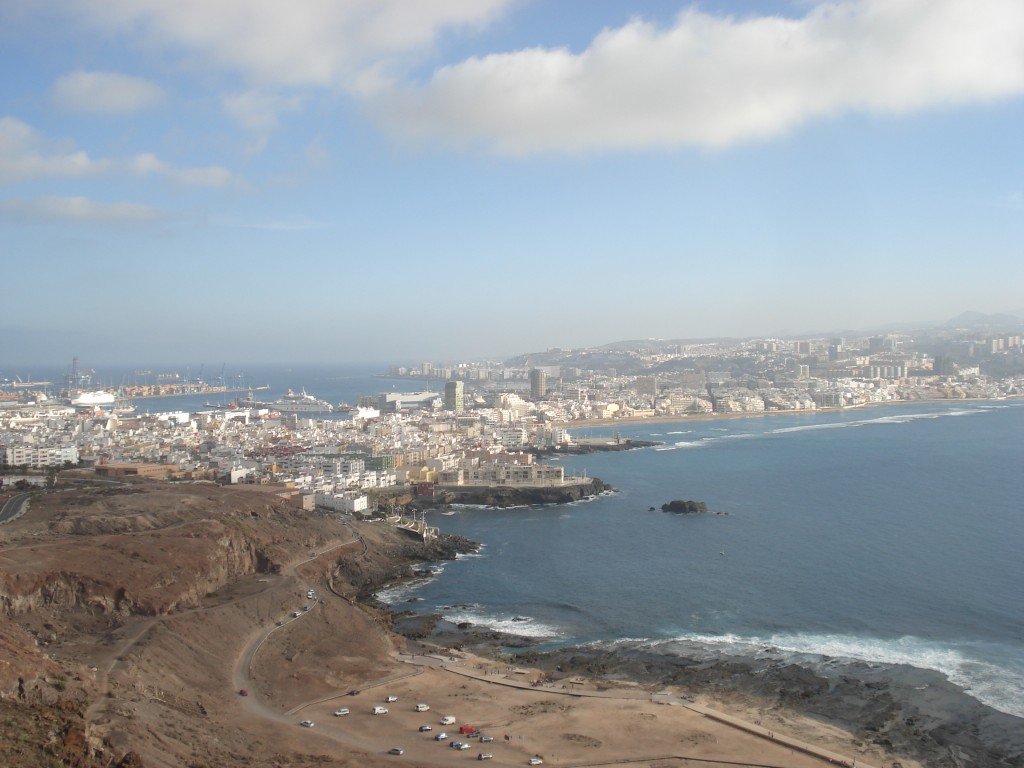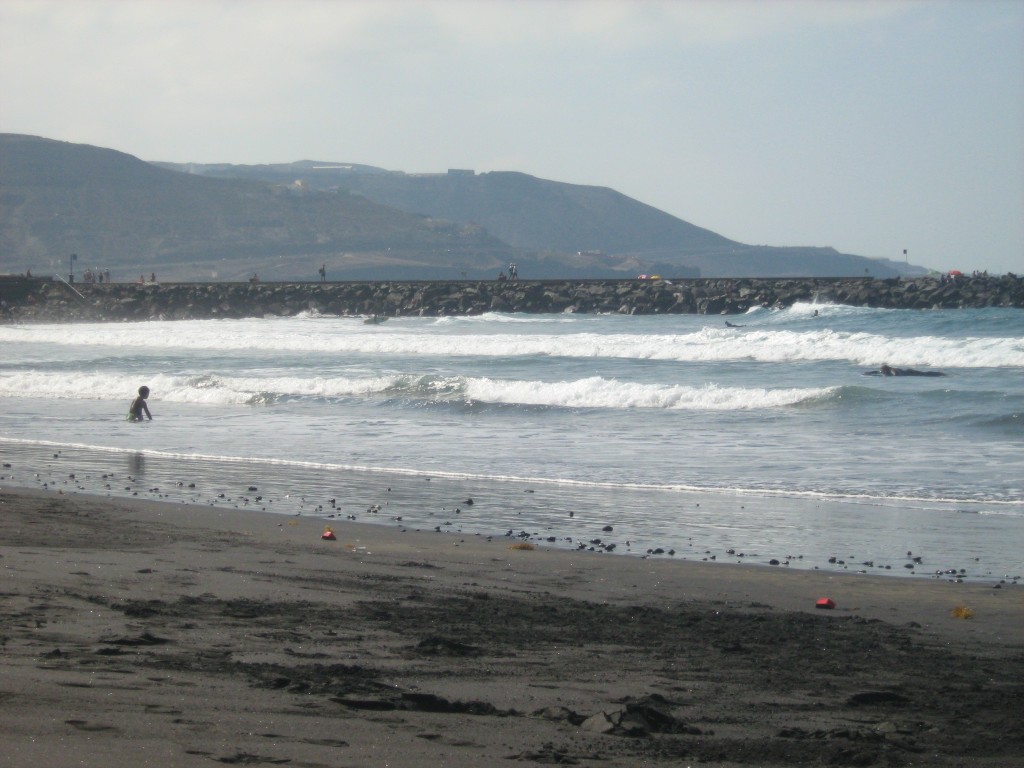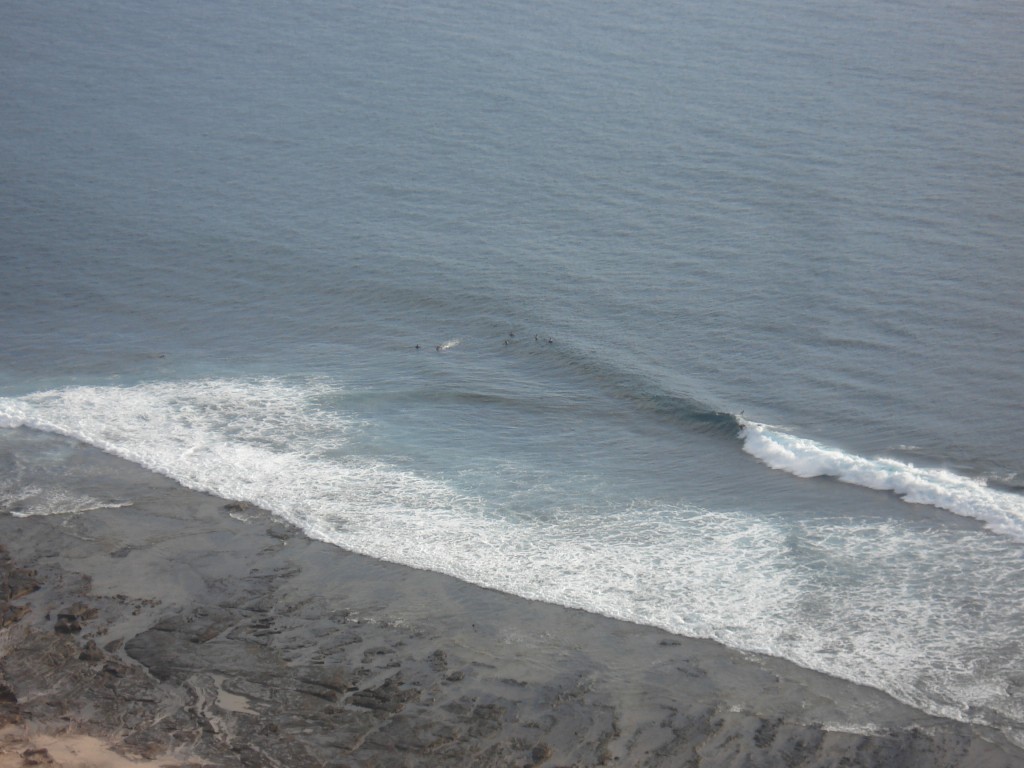Las Palmas is a city with something less than 400 thousand people, and it has a few surf spots on the north coast of the city.

Here they go the surf spots:
La Cicer
The mainstream city spot is on the west end of a long and well maintained sandy city beach, called Las Canteras. The part of the beach, used for surfing, has a darker sand and it’s called La Cicer. There are multiple peaks on this beach, and it’s working across a range of swells. Best surf can be found in the mid-tide, although there is almost always something surfable.
The peak close to the little dock on the west side is generally oriented a bit more towards the north and is usually getting a little bit bigger swell as a consequence. There are some rocks close to the relatively well defined points where the waves break, which should be taken extra care for when the tide is low.
When the swell is smaller, the wave there is not really steep nor fast, and it’s well defined and long towards the beach if you stay close to the whitewater. In smaller conditions, it’s a perfect wave for a little bit more beginner stages, and the perfect board to use is the one with good floatability.
With bigger swells, the rocky bottom produces well defined peak and a nice left wave. The inside area (closer to the beach) is often well protected by the dock when the swell is too massive for the beach to whitstand it, so if you’re in the city and need to get a swim when it’s huge (there are also strong currents in those occasions), then that’s the place to go. There is usually a rip curl close to the little dock that may help you get in the line-up quickly.
Moving toawrds the east, there is a beach with a few peaks. You can identify the peaks by the crowds. Be observant that in certain conditions, on certain peaks, there are mostly body-boarders. Going there with a surf-board won’t help you catch many waves, as those guys are catching waves that are closer to close-out. On the east side of La Cicer (close to the Red Cross), there are some rocks in the water, that may be seen when the tide is low.
The beach is equipped with Red Cross, showers, a toilet, flags to indicate the status, and is observed by lifeguards during the daytime. As a city beach, both in-water and outside water, it’s usually pretty crowded during the day. However, hitting the water at 8AM when if the conditions are good may be the best way to start the day in the city of Las Palmas, because at that time, it’s usually pretty empty.
Regarding the dangers, beware of the pickpockets on the beach and in some cases, of jelly fish in the water. The latter is more an exception that a rule, and the first one… well, maybe more a rule than an exception. So the best option is to leave only the flipflops and a towel on the beach, which isn’t hard if you are staying somewhere near the beach. Do not, by any means, leave keys and wallets on the beach alone.
Just above the beach, there is a promenade through the whole beach (“paseo”), and there you can find a few surf schools, surfboard rentals, bars and restaurants. Paseo is a nice have a seat and watch the waves breaking and people having fun in the water.
The beach is well accessible by foot, but not so well by car because there is no dedicated parking. The closest larger paking is at Lloret (see below).

Lloret
A faster, longer, more powerful and more well-defined right wave can be found just west of La Cicer, on the west side of the small docks. The shore is facing more towards the north, so it takes a bit more swell compared to La Cicer. The entry and the bottom is rocky, and the wave is well defined, so it’s not hard to figure out how to get to the line-up. It’s a faster, more powerful right wave. Don’t go there to learn, go there to surf. If you need to learn, walk a bit east to La Cicer. There is a nice large parking close to the spot, but if you are in the Las Canteras part of the city, it’s not really that far to walk to Lloret – it’s really close to La Cicer, just a bit to the left.
El Confital
A nice right wave. The shore is facing to the south-west, so the perfect swell for it is from the west side, which means that it’s often smaller than the other spots, or even flat. However, when the swell picks up, there is a well defined, powerful and fast right wave, used also for different competitions. There may be some localism present. Access to the beach by foot from the city, from the beach of Las Canteras, can be quite a tiring experience with a board in hand, but it’s not impossible. However, there is a nice large parking where you may always find some space, so the best way to go there is by some kind of a car. The beach is taken care of and nice, but in general, you won’t find a bar, rental or medics there – it’s like “being out of the city” a bit already.

The rentals, the stay, the city offerings
For the stay, check out Booking.com or Airbnb.com and look at the places close to the beach on the north side if you are going to the stay there for holidays. For surfing holiday, I can highly recommend La Ventana Azul – it’s a super-nice living hostel with a view of the beach on the terrace and a relaxed surf-life atmosphere. You can even get a private room there, but if you’re into hostel living, don’t look any further. Besides, there are some other hostels in the city.
You may rent a board in one of the many rental shops at La Cicer. They are not hard to find if you are on the promenade (“paseo”): look in one side to see the waves, and look the opposite side – and you’ll see the rental (or a sign directing you to a rental). 🙂
As we’re talking a city here, you may rest assured that there will be something to eat and to do outside your surfing endeavours. There is a shopping center close to La Cicer, and a bunch of smaller markets (ask for HiperDino or Mercadona for serious purchases) and restaurants all around. There are also some clubs in the city in case you want to get some loud music, and on the weekends, the atmosphere is generally pretty nice in the bars on the paseo. Between La Cicer and Lloret, there is also “Plaza de musica” which means “The music square”, which is alive on the weekend evenings. On Thursdays, the old part of the city, accessible with the bus (number 17 I think) or by taxi, gets alive. You can get a beer and a tapa there for an euro or so, and many people go there.
You may also rent a car in the city and make a trip to the north (or even south, if it works) shore for surfing, visit the scenic west shores of Gran Canaria, or rent a bike and make a trip towards the inside of an island. We’ll write about the other (surf/mtb) spots in some other posts, later on.
Questions? Corrections? Additions? Let us know in the comments below!
Author: Matic
Matic is tech startup guy who loves to spend time outside. In his free time he is an true outdoor freak – he tends to surf, run and ride a mountain bike, and in the winter time just loves powder skiing and snowboarding. Matic also loves to travel, often has to because of work, and even more often because he wants to 🙂



Good review. Nowadays in 2017 is Las Canteras beach very clear. There is also a La Cicer webcam for checking this place online.
Hi Maria, thanks for the update and for the link to the webcam. That’s certainly the best way to check the beach and waves at a distance.
You are welcome, I like this website. Keep your good work Urska 🙂